Syrian vs Ghanaian Community Comparison
COMPARE
Syrian
Ghanaian
Social Comparison
Social Comparison
Syrians
Ghanaians
7,975
SOCIAL INDEX
77.2/ 100
SOCIAL RATING
97th/ 347
SOCIAL RANK
2,403
SOCIAL INDEX
21.6/ 100
SOCIAL RATING
261st/ 347
SOCIAL RANK
Ghanaian Integration in Syrian Communities
The statistical analysis conducted on geographies consisting of 135,086,420 people shows a moderate positive correlation between the proportion of Ghanaians within Syrian communities in the United States with a correlation coefficient (R) of 0.436. On average, for every 1% (one percent) increase in Syrians within a typical geography, there is an increase of 0.014% in Ghanaians. To illustrate, in a geography comprising of 100,000 individuals, a rise of 1,000 Syrians corresponds to an increase of 14.2 Ghanaians.
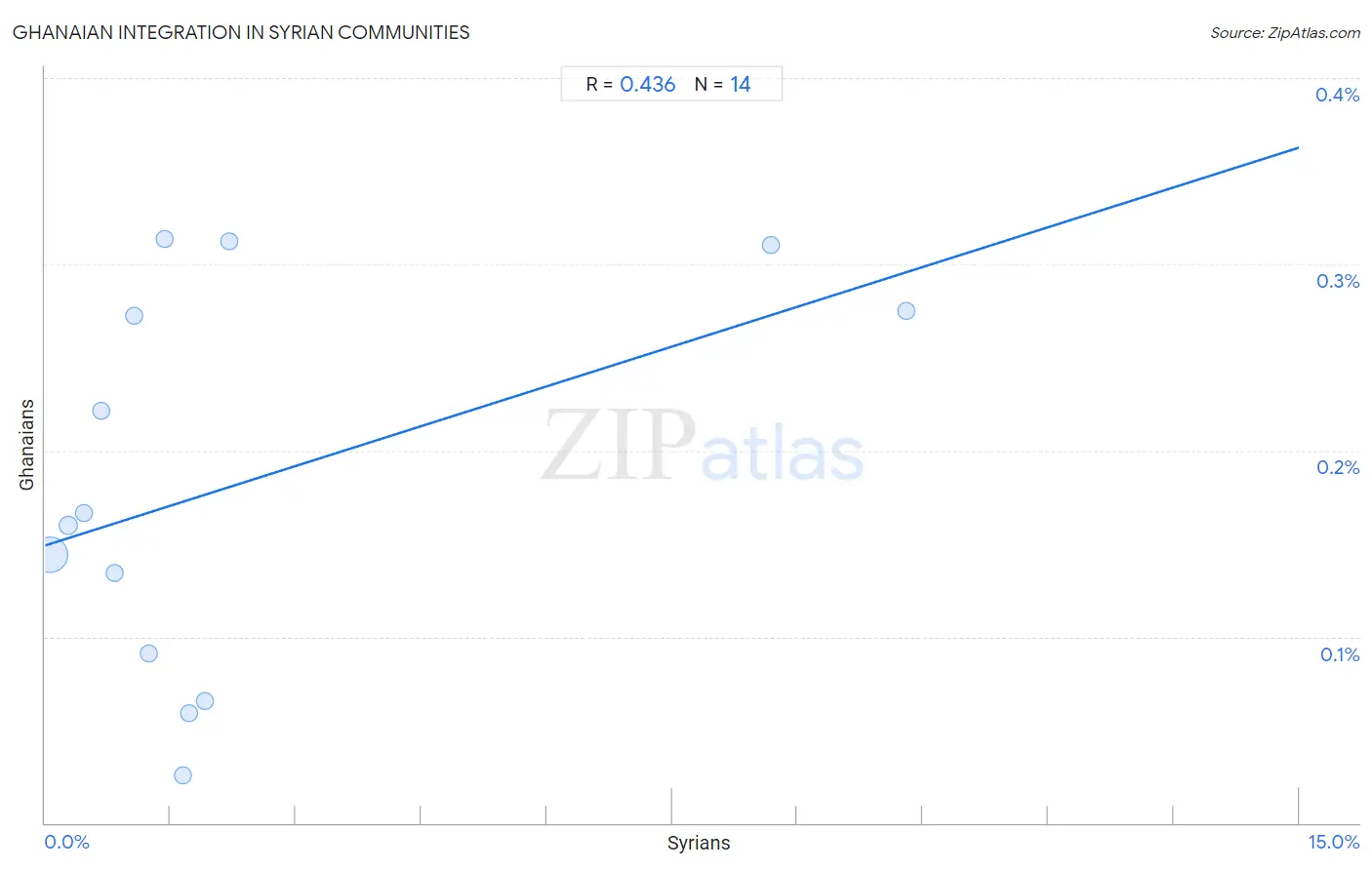
Syrian vs Ghanaian Income
When considering income, the most significant differences between Syrian and Ghanaian communities in the United States are seen in wage/income gap (27.6% compared to 22.3%, a difference of 23.4%), per capita income ($46,837 compared to $42,164, a difference of 11.1%), and median family income ($109,299 compared to $98,877, a difference of 10.5%). Conversely, both communities are more comparable in terms of median female earnings ($40,727 compared to $40,429, a difference of 0.74%), householder income under 25 years ($51,353 compared to $52,594, a difference of 2.4%), and median earnings ($48,934 compared to $46,440, a difference of 5.4%).

| Income Metric | Syrian | Ghanaian |
| Per Capita Income | Exceptional $46,837 | Poor $42,164 |
| Median Family Income | Exceptional $109,299 | Poor $98,877 |
| Median Household Income | Exceptional $89,830 | Fair $83,582 |
| Median Earnings | Exceptional $48,934 | Average $46,440 |
| Median Male Earnings | Exceptional $58,187 | Poor $52,810 |
| Median Female Earnings | Excellent $40,727 | Excellent $40,429 |
| Householder Age | Under 25 years | Poor $51,353 | Good $52,594 |
| Householder Age | 25 - 44 years | Exceptional $99,215 | Tragic $90,137 |
| Householder Age | 45 - 64 years | Exceptional $107,207 | Poor $97,277 |
| Householder Age | Over 65 years | Exceptional $63,494 | Fair $60,043 |
| Wage/Income Gap | Tragic 27.6% | Exceptional 22.3% |
Syrian vs Ghanaian Poverty
When considering poverty, the most significant differences between Syrian and Ghanaian communities in the United States are seen in receiving food stamps (11.0% compared to 14.0%, a difference of 26.7%), seniors poverty over the age of 65 (10.3% compared to 12.4%, a difference of 21.1%), and seniors poverty over the age of 75 (11.6% compared to 14.0%, a difference of 20.2%). Conversely, both communities are more comparable in terms of single father poverty (16.6% compared to 16.7%, a difference of 0.58%), single mother poverty (28.6% compared to 29.4%, a difference of 2.8%), and single male poverty (12.8% compared to 13.3%, a difference of 3.5%).
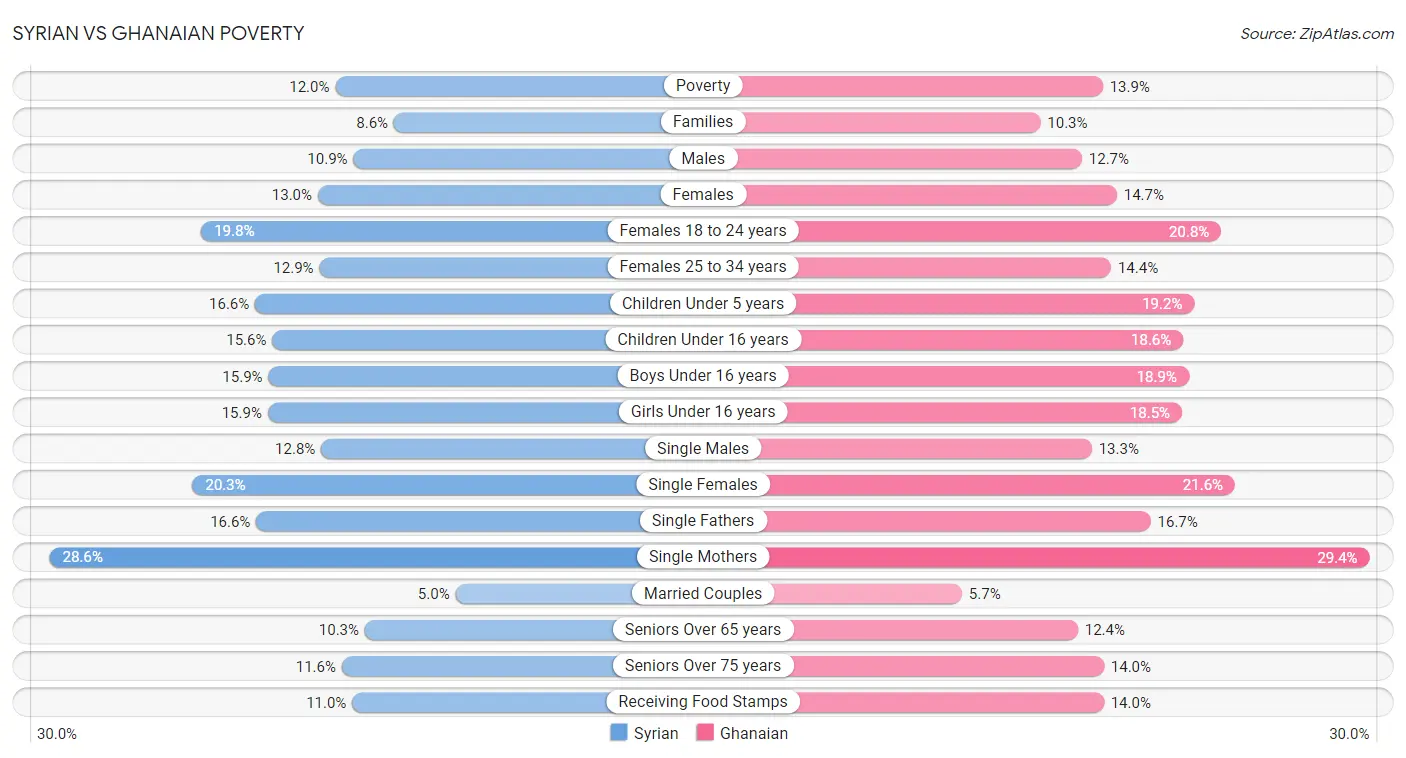
| Poverty Metric | Syrian | Ghanaian |
| Poverty | Good 12.0% | Tragic 13.9% |
| Families | Excellent 8.6% | Tragic 10.3% |
| Males | Good 10.9% | Tragic 12.7% |
| Females | Good 13.0% | Tragic 14.7% |
| Females 18 to 24 years | Excellent 19.8% | Tragic 20.8% |
| Females 25 to 34 years | Exceptional 12.9% | Tragic 14.4% |
| Children Under 5 years | Good 16.6% | Tragic 19.2% |
| Children Under 16 years | Good 15.6% | Tragic 18.6% |
| Boys Under 16 years | Good 15.9% | Tragic 18.9% |
| Girls Under 16 years | Good 15.9% | Tragic 18.5% |
| Single Males | Average 12.8% | Tragic 13.3% |
| Single Females | Exceptional 20.3% | Poor 21.6% |
| Single Fathers | Poor 16.6% | Poor 16.7% |
| Single Mothers | Excellent 28.6% | Fair 29.4% |
| Married Couples | Good 5.0% | Tragic 5.7% |
| Seniors Over 65 years | Exceptional 10.3% | Tragic 12.4% |
| Seniors Over 75 years | Exceptional 11.6% | Tragic 14.0% |
| Receiving Food Stamps | Excellent 11.0% | Tragic 14.0% |
Syrian vs Ghanaian Unemployment
When considering unemployment, the most significant differences between Syrian and Ghanaian communities in the United States are seen in male unemployment (5.2% compared to 6.1%, a difference of 17.2%), unemployment (5.2% compared to 6.0%, a difference of 16.2%), and unemployment among ages 35 to 44 years (4.6% compared to 5.3%, a difference of 16.1%). Conversely, both communities are more comparable in terms of unemployment among ages 65 to 74 years (5.4% compared to 5.6%, a difference of 3.6%), unemployment among women with children ages 6 to 17 years (9.2% compared to 9.6%, a difference of 3.8%), and unemployment among seniors over 75 years (8.7% compared to 8.4%, a difference of 4.5%).
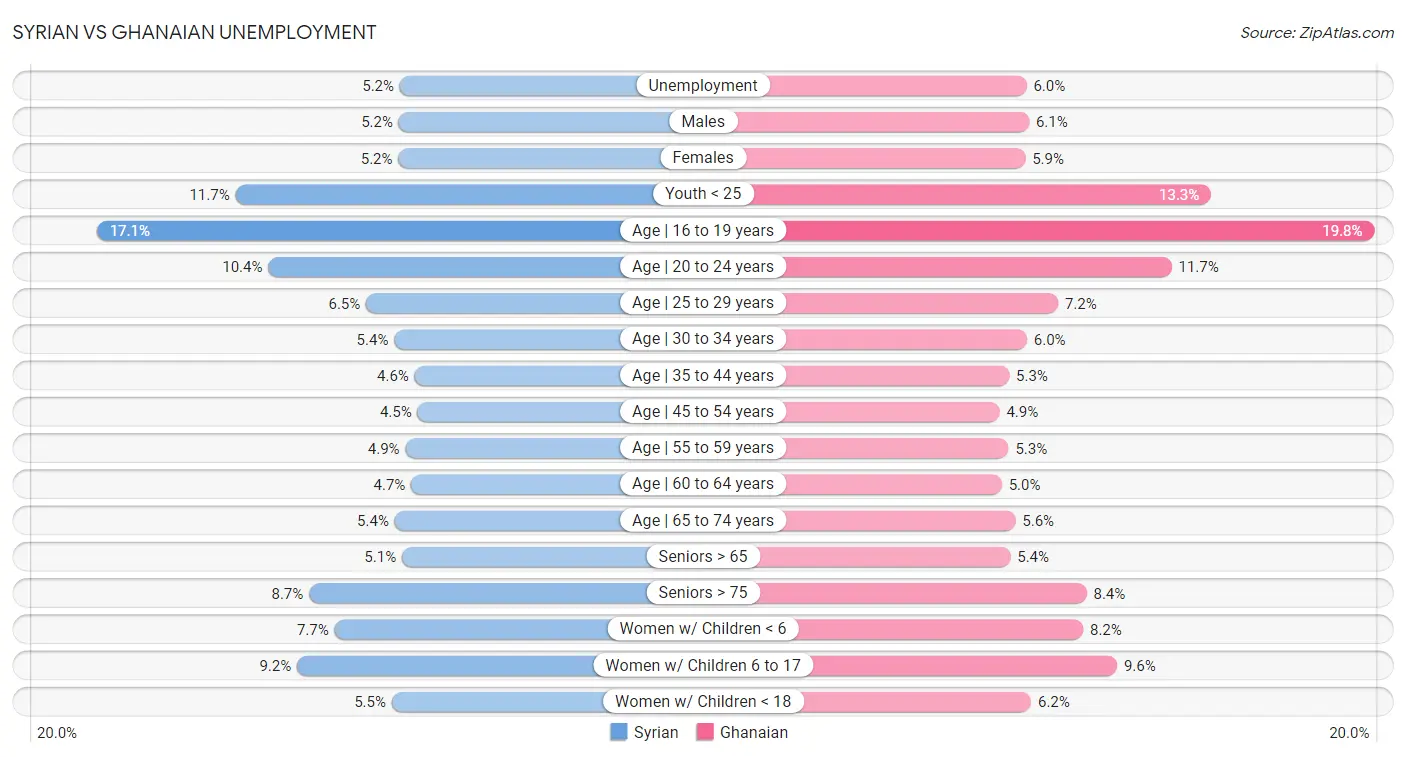
| Unemployment Metric | Syrian | Ghanaian |
| Unemployment | Good 5.2% | Tragic 6.0% |
| Males | Good 5.2% | Tragic 6.1% |
| Females | Good 5.2% | Tragic 5.9% |
| Youth < 25 | Fair 11.7% | Tragic 13.3% |
| Age | 16 to 19 years | Excellent 17.1% | Tragic 19.8% |
| Age | 20 to 24 years | Fair 10.4% | Tragic 11.7% |
| Age | 25 to 29 years | Excellent 6.5% | Tragic 7.2% |
| Age | 30 to 34 years | Good 5.4% | Tragic 6.0% |
| Age | 35 to 44 years | Excellent 4.6% | Tragic 5.3% |
| Age | 45 to 54 years | Good 4.5% | Tragic 4.9% |
| Age | 55 to 59 years | Tragic 4.9% | Tragic 5.3% |
| Age | 60 to 64 years | Exceptional 4.7% | Tragic 5.0% |
| Age | 65 to 74 years | Average 5.4% | Tragic 5.6% |
| Seniors > 65 | Excellent 5.1% | Tragic 5.4% |
| Seniors > 75 | Average 8.7% | Exceptional 8.4% |
| Women w/ Children < 6 | Fair 7.7% | Tragic 8.2% |
| Women w/ Children 6 to 17 | Tragic 9.2% | Tragic 9.6% |
| Women w/ Children < 18 | Average 5.5% | Tragic 6.2% |
Syrian vs Ghanaian Labor Participation
When considering labor participation, the most significant differences between Syrian and Ghanaian communities in the United States are seen in in labor force | age 16-19 (37.6% compared to 35.3%, a difference of 6.4%), in labor force | age > 16 (65.0% compared to 67.1%, a difference of 3.2%), and in labor force | age 20-24 (75.0% compared to 74.3%, a difference of 1.0%). Conversely, both communities are more comparable in terms of in labor force | age 25-29 (84.8% compared to 84.7%, a difference of 0.16%), in labor force | age 45-54 (82.6% compared to 83.0%, a difference of 0.53%), and in labor force | age 20-64 (79.6% compared to 80.1%, a difference of 0.68%).

| Labor Participation Metric | Syrian | Ghanaian |
| In Labor Force | Age > 16 | Average 65.0% | Exceptional 67.1% |
| In Labor Force | Age 20-64 | Average 79.6% | Exceptional 80.1% |
| In Labor Force | Age 16-19 | Exceptional 37.6% | Tragic 35.3% |
| In Labor Force | Age 20-24 | Average 75.0% | Tragic 74.3% |
| In Labor Force | Age 25-29 | Good 84.8% | Average 84.7% |
| In Labor Force | Age 30-34 | Good 84.8% | Exceptional 85.4% |
| In Labor Force | Age 35-44 | Fair 84.2% | Exceptional 84.8% |
| In Labor Force | Age 45-54 | Fair 82.6% | Good 83.0% |
Syrian vs Ghanaian Family Structure
When considering family structure, the most significant differences between Syrian and Ghanaian communities in the United States are seen in single mother households (6.0% compared to 7.8%, a difference of 30.8%), births to unmarried women (30.2% compared to 34.3%, a difference of 13.5%), and married-couple households (47.6% compared to 42.2%, a difference of 12.8%). Conversely, both communities are more comparable in terms of family households (64.5% compared to 63.5%, a difference of 1.7%), family households with children (27.8% compared to 28.5%, a difference of 2.7%), and divorced or separated (11.7% compared to 12.1%, a difference of 2.8%).

| Family Structure Metric | Syrian | Ghanaian |
| Family Households | Good 64.5% | Tragic 63.5% |
| Family Households with Children | Excellent 27.8% | Exceptional 28.5% |
| Married-couple Households | Exceptional 47.6% | Tragic 42.2% |
| Average Family Size | Tragic 3.19 | Exceptional 3.29 |
| Single Father Households | Exceptional 2.2% | Poor 2.4% |
| Single Mother Households | Excellent 6.0% | Tragic 7.8% |
| Currently Married | Excellent 47.5% | Tragic 42.9% |
| Divorced or Separated | Exceptional 11.7% | Average 12.1% |
| Births to Unmarried Women | Excellent 30.2% | Tragic 34.3% |
Syrian vs Ghanaian Vehicle Availability
When considering vehicle availability, the most significant differences between Syrian and Ghanaian communities in the United States are seen in no vehicles in household (9.7% compared to 16.4%, a difference of 69.0%), 4 or more vehicles in household (6.3% compared to 5.2%, a difference of 19.6%), and 3 or more vehicles in household (19.5% compared to 16.4%, a difference of 18.9%). Conversely, both communities are more comparable in terms of 1 or more vehicles in household (90.3% compared to 83.6%, a difference of 8.0%), 2 or more vehicles in household (56.2% compared to 48.0%, a difference of 17.1%), and 3 or more vehicles in household (19.5% compared to 16.4%, a difference of 18.9%).

| Vehicle Availability Metric | Syrian | Ghanaian |
| No Vehicles Available | Excellent 9.7% | Tragic 16.4% |
| 1+ Vehicles Available | Excellent 90.3% | Tragic 83.6% |
| 2+ Vehicles Available | Excellent 56.2% | Tragic 48.0% |
| 3+ Vehicles Available | Average 19.5% | Tragic 16.4% |
| 4+ Vehicles Available | Average 6.3% | Tragic 5.2% |
Syrian vs Ghanaian Education Level
When considering education level, the most significant differences between Syrian and Ghanaian communities in the United States are seen in no schooling completed (1.9% compared to 2.6%, a difference of 37.0%), professional degree (5.2% compared to 4.3%, a difference of 21.4%), and doctorate degree (2.1% compared to 1.8%, a difference of 13.2%). Conversely, both communities are more comparable in terms of nursery school (98.2% compared to 97.5%, a difference of 0.72%), kindergarten (98.2% compared to 97.4%, a difference of 0.73%), and 1st grade (98.1% compared to 97.4%, a difference of 0.74%).
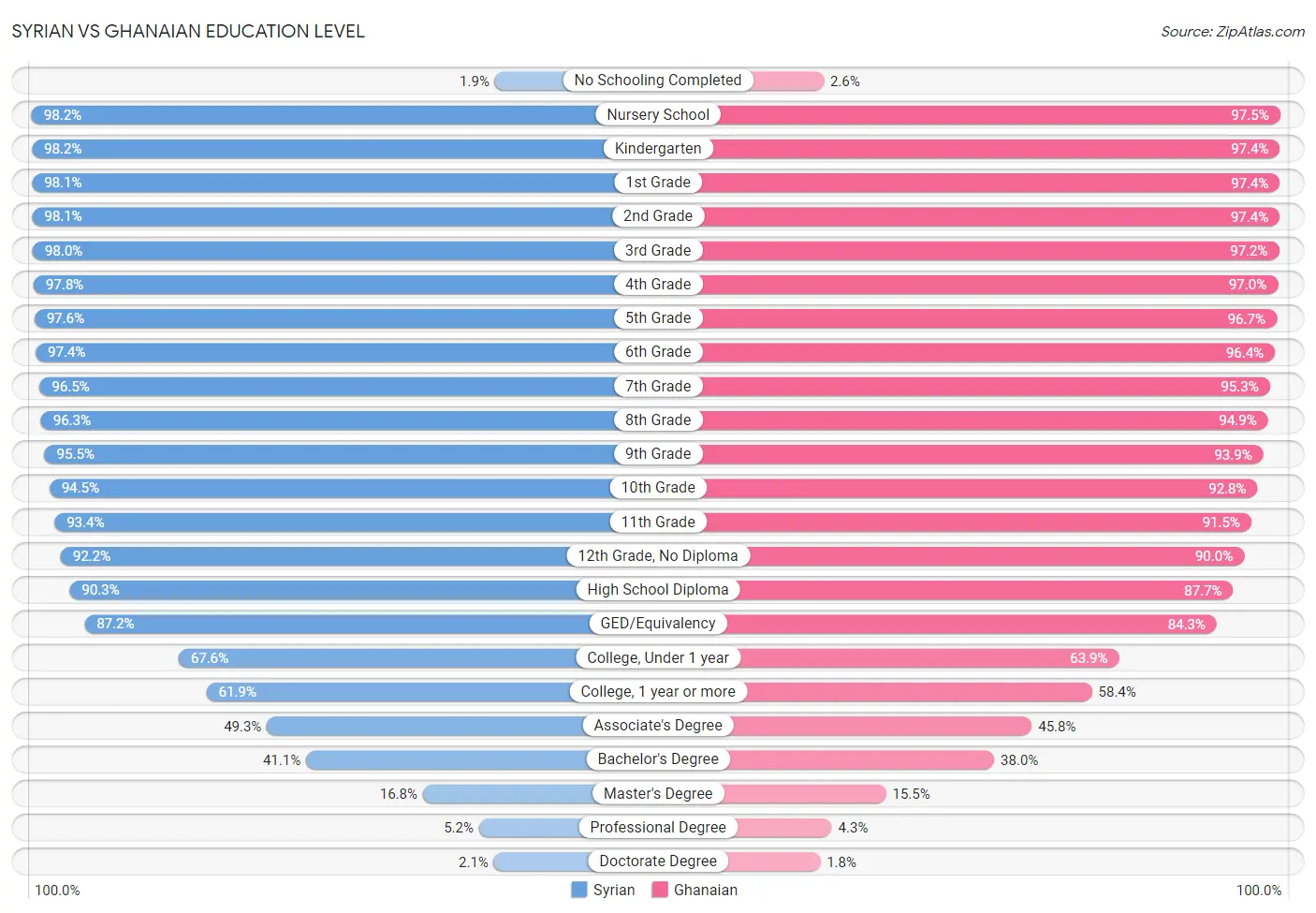
| Education Level Metric | Syrian | Ghanaian |
| No Schooling Completed | Exceptional 1.9% | Tragic 2.6% |
| Nursery School | Exceptional 98.2% | Tragic 97.5% |
| Kindergarten | Exceptional 98.2% | Tragic 97.4% |
| 1st Grade | Exceptional 98.1% | Tragic 97.4% |
| 2nd Grade | Exceptional 98.1% | Tragic 97.4% |
| 3rd Grade | Exceptional 98.0% | Tragic 97.2% |
| 4th Grade | Exceptional 97.8% | Tragic 97.0% |
| 5th Grade | Exceptional 97.6% | Tragic 96.7% |
| 6th Grade | Exceptional 97.4% | Tragic 96.4% |
| 7th Grade | Exceptional 96.5% | Tragic 95.3% |
| 8th Grade | Exceptional 96.3% | Tragic 94.9% |
| 9th Grade | Exceptional 95.5% | Tragic 93.9% |
| 10th Grade | Exceptional 94.5% | Tragic 92.8% |
| 11th Grade | Exceptional 93.4% | Tragic 91.5% |
| 12th Grade, No Diploma | Exceptional 92.2% | Tragic 90.0% |
| High School Diploma | Exceptional 90.3% | Tragic 87.7% |
| GED/Equivalency | Exceptional 87.2% | Tragic 84.3% |
| College, Under 1 year | Exceptional 67.6% | Poor 63.9% |
| College, 1 year or more | Exceptional 61.9% | Fair 58.4% |
| Associate's Degree | Exceptional 49.3% | Fair 45.8% |
| Bachelor's Degree | Exceptional 41.1% | Average 38.0% |
| Master's Degree | Exceptional 16.8% | Good 15.5% |
| Professional Degree | Exceptional 5.2% | Fair 4.3% |
| Doctorate Degree | Exceptional 2.1% | Average 1.8% |
Syrian vs Ghanaian Disability
When considering disability, the most significant differences between Syrian and Ghanaian communities in the United States are seen in hearing disability (3.1% compared to 2.5%, a difference of 21.4%), disability age 65 to 74 (22.3% compared to 24.1%, a difference of 7.9%), and cognitive disability (17.1% compared to 18.3%, a difference of 6.9%). Conversely, both communities are more comparable in terms of female disability (12.1% compared to 12.1%, a difference of 0.020%), ambulatory disability (6.0% compared to 6.0%, a difference of 0.29%), and disability age 18 to 34 (6.6% compared to 6.6%, a difference of 0.73%).
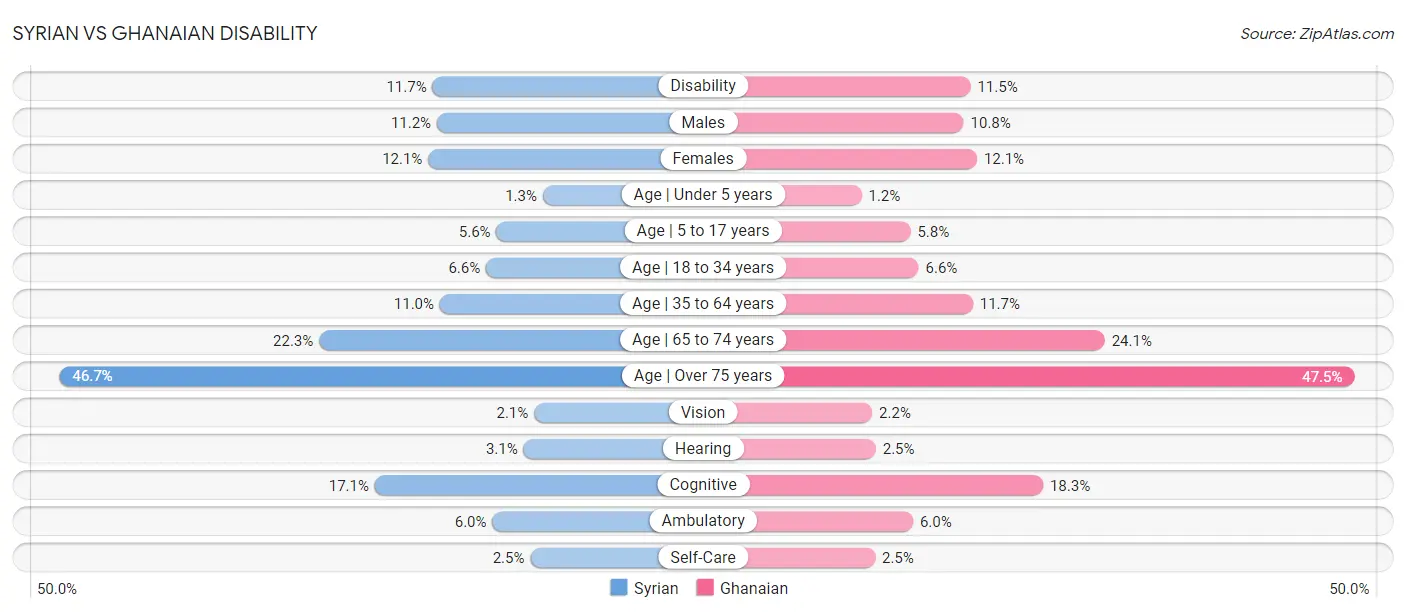
| Disability Metric | Syrian | Ghanaian |
| Disability | Average 11.7% | Excellent 11.5% |
| Males | Average 11.2% | Exceptional 10.8% |
| Females | Good 12.1% | Good 12.1% |
| Age | Under 5 years | Poor 1.3% | Good 1.2% |
| Age | 5 to 17 years | Fair 5.6% | Tragic 5.8% |
| Age | 18 to 34 years | Average 6.6% | Average 6.6% |
| Age | 35 to 64 years | Good 11.0% | Poor 11.7% |
| Age | 65 to 74 years | Exceptional 22.3% | Poor 24.1% |
| Age | Over 75 years | Exceptional 46.7% | Fair 47.5% |
| Vision | Excellent 2.1% | Fair 2.2% |
| Hearing | Poor 3.1% | Exceptional 2.5% |
| Cognitive | Excellent 17.1% | Tragic 18.3% |
| Ambulatory | Good 6.0% | Good 6.0% |
| Self-Care | Average 2.5% | Average 2.5% |